Food Waste Metrics: Application Development and Analysis
VerifiedAdded on 2022/08/17
|10
|2476
|21
Project
AI Summary
This project delves into the critical issue of food waste and explores the development of sustainable food waste metrics and an application to measure and mitigate this problem. The research begins with a thorough background analysis, examining the economic, social, and environmental impacts of food waste, which often results in large portions of food being sent to landfills. The project aims to analyze the reasons behind food wastage, develop sustainable food waste metrics, and investigate the potential of an application to track and reduce waste. The research questions address the causes of food waste, the development of sustainable metrics, application possibilities, and how to improve existing metrics. A literature review highlights the significance of food waste as a sustainability issue and explores existing research on the topic, including waste at the household level and along the supply chain. The research methodology will employ a qualitative approach, incorporating surveys with closed-ended questions to gather insights from respondents about food waste and potential solutions. The conclusion underscores the need for an application to support sustainability in food production, emphasizing the importance of public awareness and individual responsibility in reducing food waste, especially considering the challenges of population growth and resource scarcity. The project emphasizes the importance of consistent methodologies and terminology to measure and address food waste effectively.
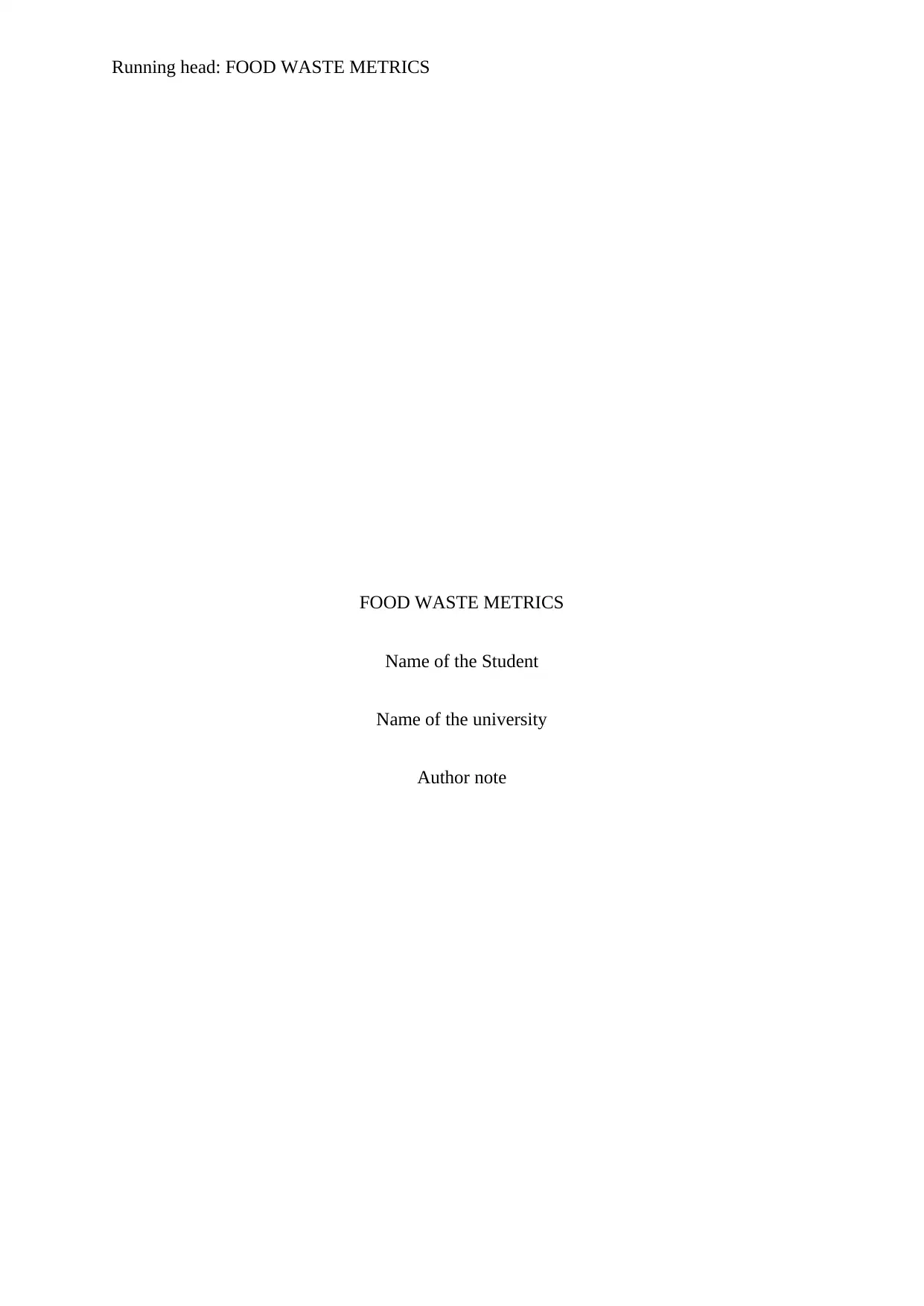
Running head: FOOD WASTE METRICS
FOOD WASTE METRICS
Name of the Student
Name of the university
Author note
FOOD WASTE METRICS
Name of the Student
Name of the university
Author note
Paraphrase This Document
Need a fresh take? Get an instant paraphrase of this document with our AI Paraphraser
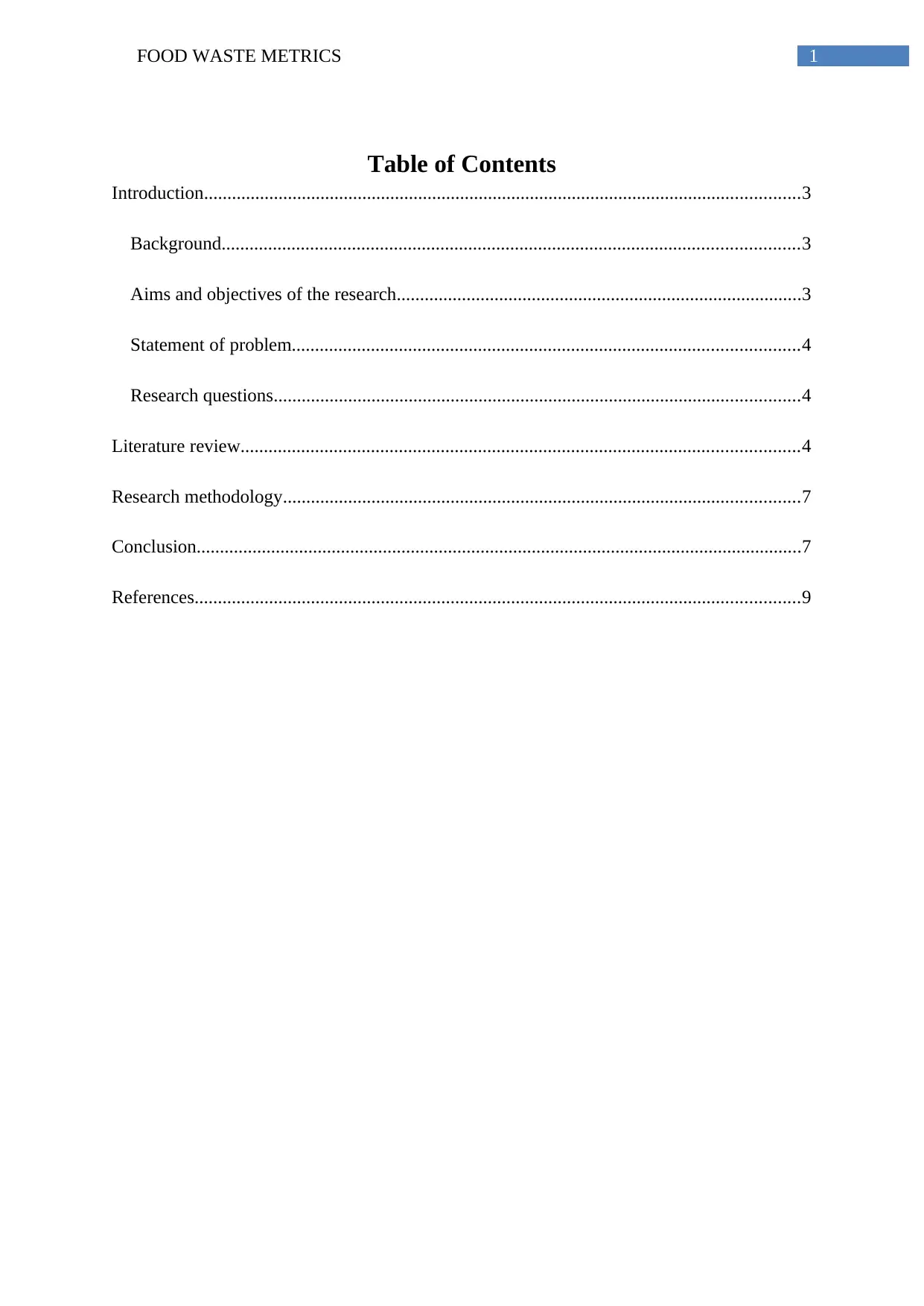
1FOOD WASTE METRICS
Table of Contents
Introduction................................................................................................................................3
Background............................................................................................................................3
Aims and objectives of the research.......................................................................................3
Statement of problem.............................................................................................................4
Research questions.................................................................................................................4
Literature review........................................................................................................................4
Research methodology...............................................................................................................7
Conclusion..................................................................................................................................7
References..................................................................................................................................9
Table of Contents
Introduction................................................................................................................................3
Background............................................................................................................................3
Aims and objectives of the research.......................................................................................3
Statement of problem.............................................................................................................4
Research questions.................................................................................................................4
Literature review........................................................................................................................4
Research methodology...............................................................................................................7
Conclusion..................................................................................................................................7
References..................................................................................................................................9
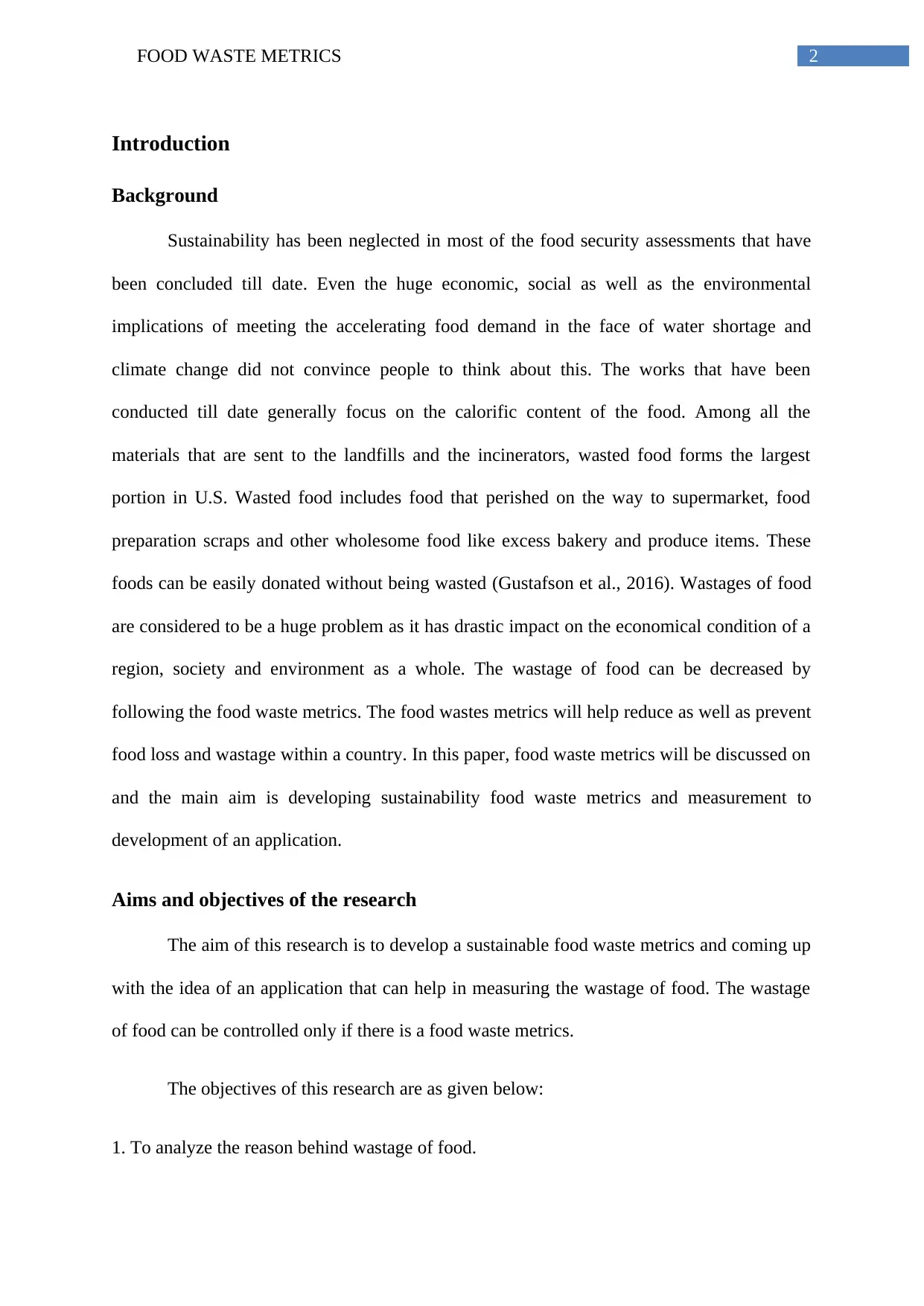
2FOOD WASTE METRICS
Introduction
Background
Sustainability has been neglected in most of the food security assessments that have
been concluded till date. Even the huge economic, social as well as the environmental
implications of meeting the accelerating food demand in the face of water shortage and
climate change did not convince people to think about this. The works that have been
conducted till date generally focus on the calorific content of the food. Among all the
materials that are sent to the landfills and the incinerators, wasted food forms the largest
portion in U.S. Wasted food includes food that perished on the way to supermarket, food
preparation scraps and other wholesome food like excess bakery and produce items. These
foods can be easily donated without being wasted (Gustafson et al., 2016). Wastages of food
are considered to be a huge problem as it has drastic impact on the economical condition of a
region, society and environment as a whole. The wastage of food can be decreased by
following the food waste metrics. The food wastes metrics will help reduce as well as prevent
food loss and wastage within a country. In this paper, food waste metrics will be discussed on
and the main aim is developing sustainability food waste metrics and measurement to
development of an application.
Aims and objectives of the research
The aim of this research is to develop a sustainable food waste metrics and coming up
with the idea of an application that can help in measuring the wastage of food. The wastage
of food can be controlled only if there is a food waste metrics.
The objectives of this research are as given below:
1. To analyze the reason behind wastage of food.
Introduction
Background
Sustainability has been neglected in most of the food security assessments that have
been concluded till date. Even the huge economic, social as well as the environmental
implications of meeting the accelerating food demand in the face of water shortage and
climate change did not convince people to think about this. The works that have been
conducted till date generally focus on the calorific content of the food. Among all the
materials that are sent to the landfills and the incinerators, wasted food forms the largest
portion in U.S. Wasted food includes food that perished on the way to supermarket, food
preparation scraps and other wholesome food like excess bakery and produce items. These
foods can be easily donated without being wasted (Gustafson et al., 2016). Wastages of food
are considered to be a huge problem as it has drastic impact on the economical condition of a
region, society and environment as a whole. The wastage of food can be decreased by
following the food waste metrics. The food wastes metrics will help reduce as well as prevent
food loss and wastage within a country. In this paper, food waste metrics will be discussed on
and the main aim is developing sustainability food waste metrics and measurement to
development of an application.
Aims and objectives of the research
The aim of this research is to develop a sustainable food waste metrics and coming up
with the idea of an application that can help in measuring the wastage of food. The wastage
of food can be controlled only if there is a food waste metrics.
The objectives of this research are as given below:
1. To analyze the reason behind wastage of food.
⊘ This is a preview!⊘
Do you want full access?
Subscribe today to unlock all pages.

Trusted by 1+ million students worldwide
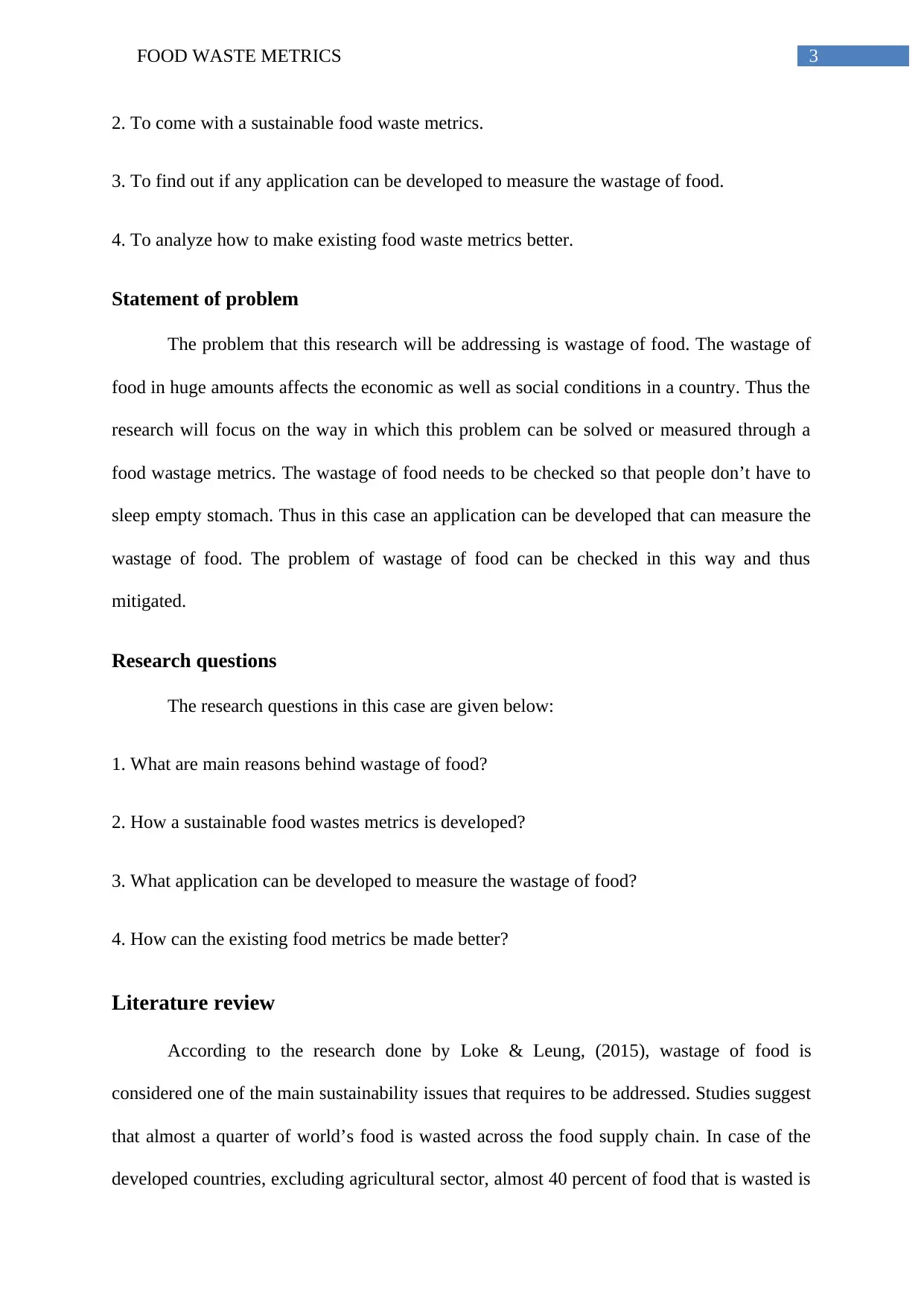
3FOOD WASTE METRICS
2. To come with a sustainable food waste metrics.
3. To find out if any application can be developed to measure the wastage of food.
4. To analyze how to make existing food waste metrics better.
Statement of problem
The problem that this research will be addressing is wastage of food. The wastage of
food in huge amounts affects the economic as well as social conditions in a country. Thus the
research will focus on the way in which this problem can be solved or measured through a
food wastage metrics. The wastage of food needs to be checked so that people don’t have to
sleep empty stomach. Thus in this case an application can be developed that can measure the
wastage of food. The problem of wastage of food can be checked in this way and thus
mitigated.
Research questions
The research questions in this case are given below:
1. What are main reasons behind wastage of food?
2. How a sustainable food wastes metrics is developed?
3. What application can be developed to measure the wastage of food?
4. How can the existing food metrics be made better?
Literature review
According to the research done by Loke & Leung, (2015), wastage of food is
considered one of the main sustainability issues that requires to be addressed. Studies suggest
that almost a quarter of world’s food is wasted across the food supply chain. In case of the
developed countries, excluding agricultural sector, almost 40 percent of food that is wasted is
2. To come with a sustainable food waste metrics.
3. To find out if any application can be developed to measure the wastage of food.
4. To analyze how to make existing food waste metrics better.
Statement of problem
The problem that this research will be addressing is wastage of food. The wastage of
food in huge amounts affects the economic as well as social conditions in a country. Thus the
research will focus on the way in which this problem can be solved or measured through a
food wastage metrics. The wastage of food needs to be checked so that people don’t have to
sleep empty stomach. Thus in this case an application can be developed that can measure the
wastage of food. The problem of wastage of food can be checked in this way and thus
mitigated.
Research questions
The research questions in this case are given below:
1. What are main reasons behind wastage of food?
2. How a sustainable food wastes metrics is developed?
3. What application can be developed to measure the wastage of food?
4. How can the existing food metrics be made better?
Literature review
According to the research done by Loke & Leung, (2015), wastage of food is
considered one of the main sustainability issues that requires to be addressed. Studies suggest
that almost a quarter of world’s food is wasted across the food supply chain. In case of the
developed countries, excluding agricultural sector, almost 40 percent of food that is wasted is
Paraphrase This Document
Need a fresh take? Get an instant paraphrase of this document with our AI Paraphraser
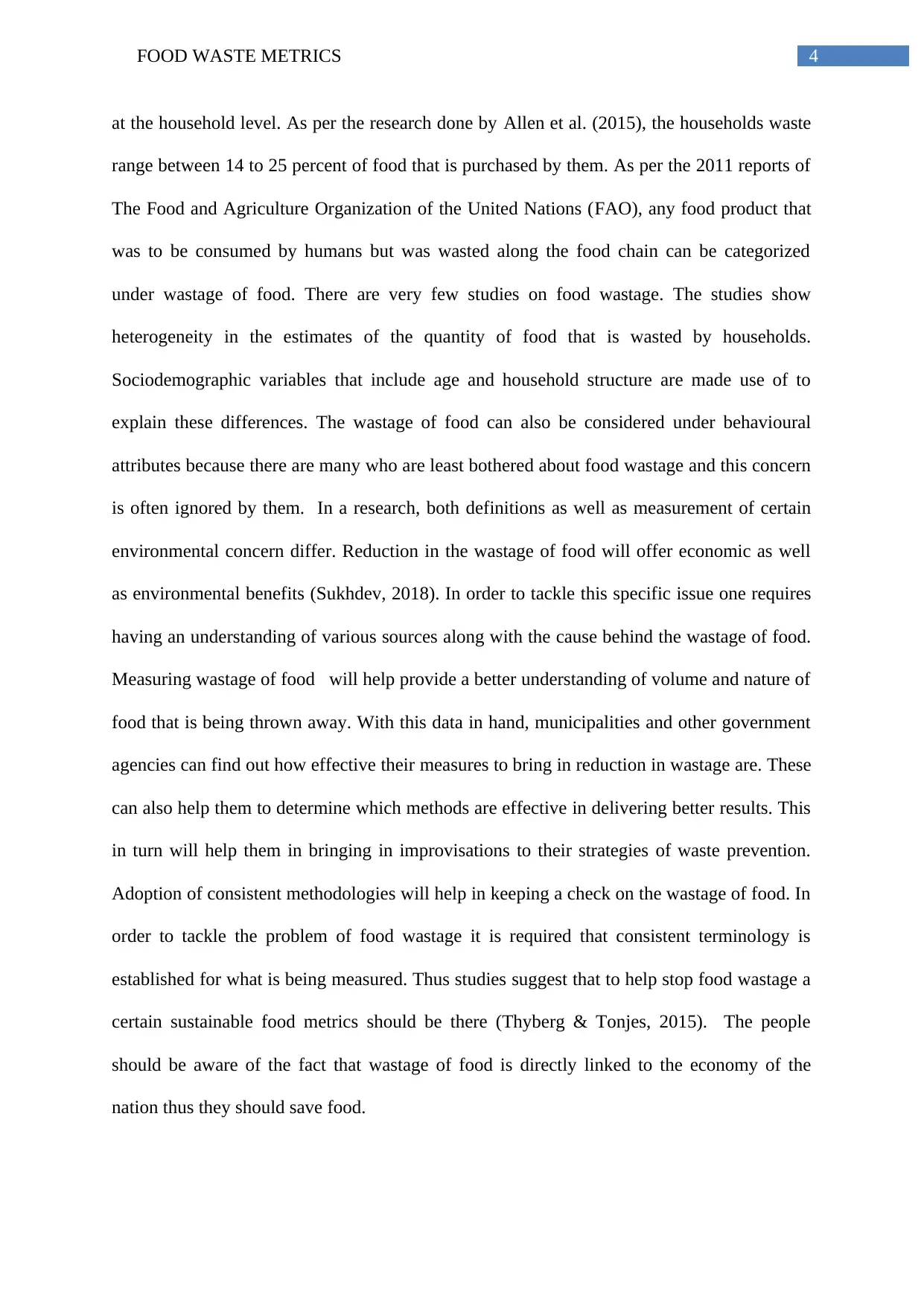
4FOOD WASTE METRICS
at the household level. As per the research done by Allen et al. (2015), the households waste
range between 14 to 25 percent of food that is purchased by them. As per the 2011 reports of
The Food and Agriculture Organization of the United Nations (FAO), any food product that
was to be consumed by humans but was wasted along the food chain can be categorized
under wastage of food. There are very few studies on food wastage. The studies show
heterogeneity in the estimates of the quantity of food that is wasted by households.
Sociodemographic variables that include age and household structure are made use of to
explain these differences. The wastage of food can also be considered under behavioural
attributes because there are many who are least bothered about food wastage and this concern
is often ignored by them. In a research, both definitions as well as measurement of certain
environmental concern differ. Reduction in the wastage of food will offer economic as well
as environmental benefits (Sukhdev, 2018). In order to tackle this specific issue one requires
having an understanding of various sources along with the cause behind the wastage of food.
Measuring wastage of food will help provide a better understanding of volume and nature of
food that is being thrown away. With this data in hand, municipalities and other government
agencies can find out how effective their measures to bring in reduction in wastage are. These
can also help them to determine which methods are effective in delivering better results. This
in turn will help them in bringing in improvisations to their strategies of waste prevention.
Adoption of consistent methodologies will help in keeping a check on the wastage of food. In
order to tackle the problem of food wastage it is required that consistent terminology is
established for what is being measured. Thus studies suggest that to help stop food wastage a
certain sustainable food metrics should be there (Thyberg & Tonjes, 2015). The people
should be aware of the fact that wastage of food is directly linked to the economy of the
nation thus they should save food.
at the household level. As per the research done by Allen et al. (2015), the households waste
range between 14 to 25 percent of food that is purchased by them. As per the 2011 reports of
The Food and Agriculture Organization of the United Nations (FAO), any food product that
was to be consumed by humans but was wasted along the food chain can be categorized
under wastage of food. There are very few studies on food wastage. The studies show
heterogeneity in the estimates of the quantity of food that is wasted by households.
Sociodemographic variables that include age and household structure are made use of to
explain these differences. The wastage of food can also be considered under behavioural
attributes because there are many who are least bothered about food wastage and this concern
is often ignored by them. In a research, both definitions as well as measurement of certain
environmental concern differ. Reduction in the wastage of food will offer economic as well
as environmental benefits (Sukhdev, 2018). In order to tackle this specific issue one requires
having an understanding of various sources along with the cause behind the wastage of food.
Measuring wastage of food will help provide a better understanding of volume and nature of
food that is being thrown away. With this data in hand, municipalities and other government
agencies can find out how effective their measures to bring in reduction in wastage are. These
can also help them to determine which methods are effective in delivering better results. This
in turn will help them in bringing in improvisations to their strategies of waste prevention.
Adoption of consistent methodologies will help in keeping a check on the wastage of food. In
order to tackle the problem of food wastage it is required that consistent terminology is
established for what is being measured. Thus studies suggest that to help stop food wastage a
certain sustainable food metrics should be there (Thyberg & Tonjes, 2015). The people
should be aware of the fact that wastage of food is directly linked to the economy of the
nation thus they should save food.
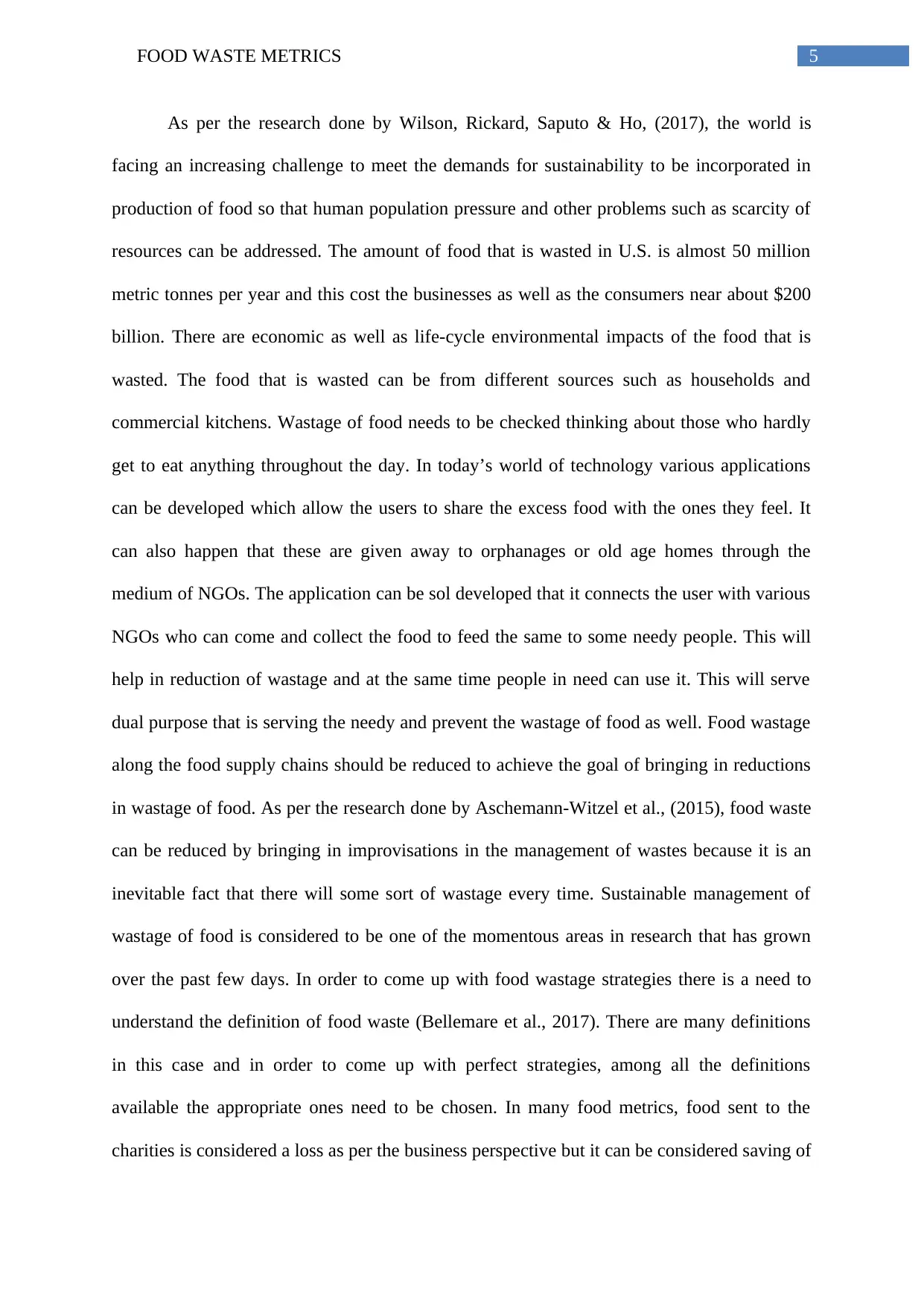
5FOOD WASTE METRICS
As per the research done by Wilson, Rickard, Saputo & Ho, (2017), the world is
facing an increasing challenge to meet the demands for sustainability to be incorporated in
production of food so that human population pressure and other problems such as scarcity of
resources can be addressed. The amount of food that is wasted in U.S. is almost 50 million
metric tonnes per year and this cost the businesses as well as the consumers near about $200
billion. There are economic as well as life-cycle environmental impacts of the food that is
wasted. The food that is wasted can be from different sources such as households and
commercial kitchens. Wastage of food needs to be checked thinking about those who hardly
get to eat anything throughout the day. In today’s world of technology various applications
can be developed which allow the users to share the excess food with the ones they feel. It
can also happen that these are given away to orphanages or old age homes through the
medium of NGOs. The application can be sol developed that it connects the user with various
NGOs who can come and collect the food to feed the same to some needy people. This will
help in reduction of wastage and at the same time people in need can use it. This will serve
dual purpose that is serving the needy and prevent the wastage of food as well. Food wastage
along the food supply chains should be reduced to achieve the goal of bringing in reductions
in wastage of food. As per the research done by Aschemann-Witzel et al., (2015), food waste
can be reduced by bringing in improvisations in the management of wastes because it is an
inevitable fact that there will some sort of wastage every time. Sustainable management of
wastage of food is considered to be one of the momentous areas in research that has grown
over the past few days. In order to come up with food wastage strategies there is a need to
understand the definition of food waste (Bellemare et al., 2017). There are many definitions
in this case and in order to come up with perfect strategies, among all the definitions
available the appropriate ones need to be chosen. In many food metrics, food sent to the
charities is considered a loss as per the business perspective but it can be considered saving of
As per the research done by Wilson, Rickard, Saputo & Ho, (2017), the world is
facing an increasing challenge to meet the demands for sustainability to be incorporated in
production of food so that human population pressure and other problems such as scarcity of
resources can be addressed. The amount of food that is wasted in U.S. is almost 50 million
metric tonnes per year and this cost the businesses as well as the consumers near about $200
billion. There are economic as well as life-cycle environmental impacts of the food that is
wasted. The food that is wasted can be from different sources such as households and
commercial kitchens. Wastage of food needs to be checked thinking about those who hardly
get to eat anything throughout the day. In today’s world of technology various applications
can be developed which allow the users to share the excess food with the ones they feel. It
can also happen that these are given away to orphanages or old age homes through the
medium of NGOs. The application can be sol developed that it connects the user with various
NGOs who can come and collect the food to feed the same to some needy people. This will
help in reduction of wastage and at the same time people in need can use it. This will serve
dual purpose that is serving the needy and prevent the wastage of food as well. Food wastage
along the food supply chains should be reduced to achieve the goal of bringing in reductions
in wastage of food. As per the research done by Aschemann-Witzel et al., (2015), food waste
can be reduced by bringing in improvisations in the management of wastes because it is an
inevitable fact that there will some sort of wastage every time. Sustainable management of
wastage of food is considered to be one of the momentous areas in research that has grown
over the past few days. In order to come up with food wastage strategies there is a need to
understand the definition of food waste (Bellemare et al., 2017). There are many definitions
in this case and in order to come up with perfect strategies, among all the definitions
available the appropriate ones need to be chosen. In many food metrics, food sent to the
charities is considered a loss as per the business perspective but it can be considered saving of
⊘ This is a preview!⊘
Do you want full access?
Subscribe today to unlock all pages.

Trusted by 1+ million students worldwide
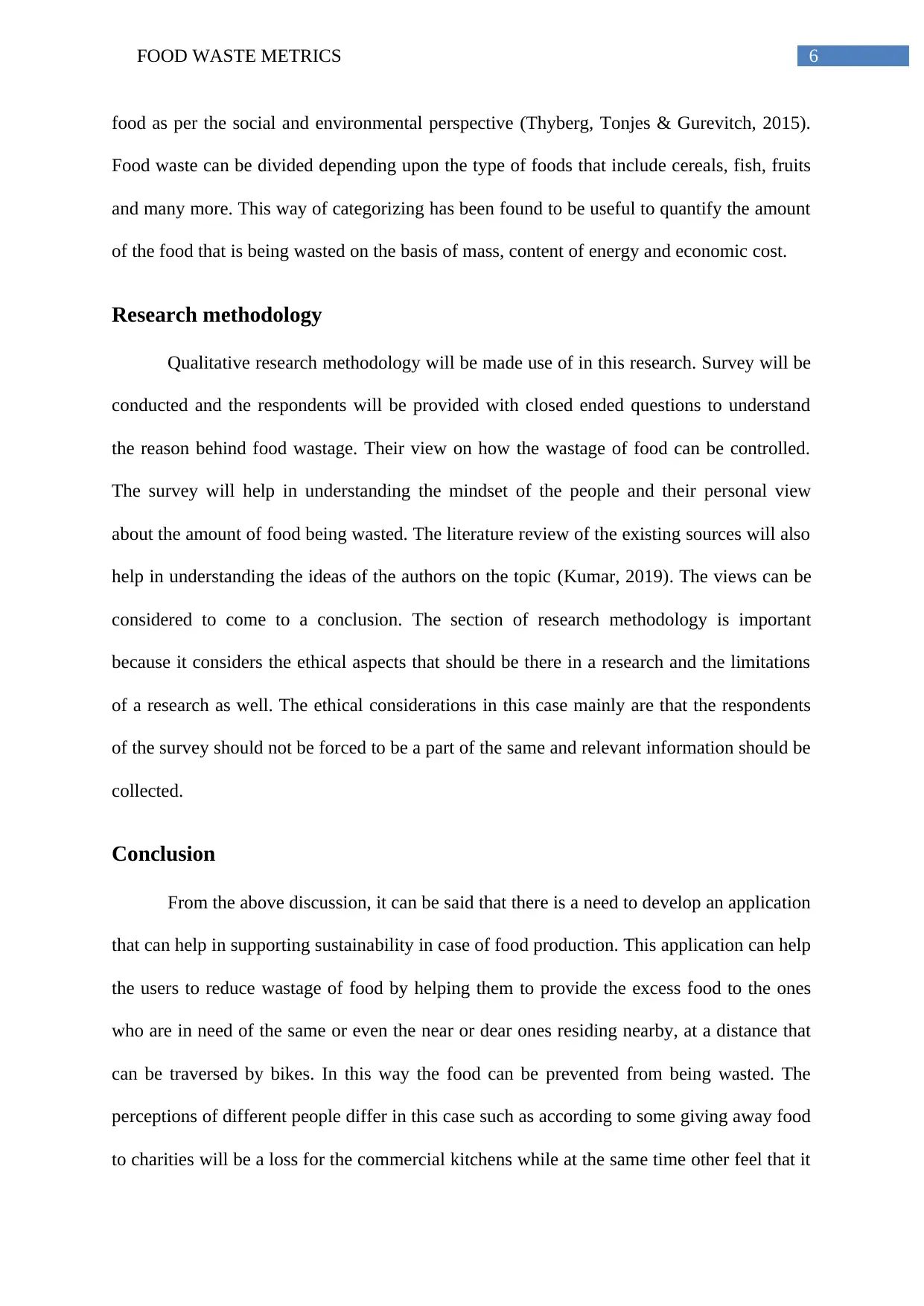
6FOOD WASTE METRICS
food as per the social and environmental perspective (Thyberg, Tonjes & Gurevitch, 2015).
Food waste can be divided depending upon the type of foods that include cereals, fish, fruits
and many more. This way of categorizing has been found to be useful to quantify the amount
of the food that is being wasted on the basis of mass, content of energy and economic cost.
Research methodology
Qualitative research methodology will be made use of in this research. Survey will be
conducted and the respondents will be provided with closed ended questions to understand
the reason behind food wastage. Their view on how the wastage of food can be controlled.
The survey will help in understanding the mindset of the people and their personal view
about the amount of food being wasted. The literature review of the existing sources will also
help in understanding the ideas of the authors on the topic (Kumar, 2019). The views can be
considered to come to a conclusion. The section of research methodology is important
because it considers the ethical aspects that should be there in a research and the limitations
of a research as well. The ethical considerations in this case mainly are that the respondents
of the survey should not be forced to be a part of the same and relevant information should be
collected.
Conclusion
From the above discussion, it can be said that there is a need to develop an application
that can help in supporting sustainability in case of food production. This application can help
the users to reduce wastage of food by helping them to provide the excess food to the ones
who are in need of the same or even the near or dear ones residing nearby, at a distance that
can be traversed by bikes. In this way the food can be prevented from being wasted. The
perceptions of different people differ in this case such as according to some giving away food
to charities will be a loss for the commercial kitchens while at the same time other feel that it
food as per the social and environmental perspective (Thyberg, Tonjes & Gurevitch, 2015).
Food waste can be divided depending upon the type of foods that include cereals, fish, fruits
and many more. This way of categorizing has been found to be useful to quantify the amount
of the food that is being wasted on the basis of mass, content of energy and economic cost.
Research methodology
Qualitative research methodology will be made use of in this research. Survey will be
conducted and the respondents will be provided with closed ended questions to understand
the reason behind food wastage. Their view on how the wastage of food can be controlled.
The survey will help in understanding the mindset of the people and their personal view
about the amount of food being wasted. The literature review of the existing sources will also
help in understanding the ideas of the authors on the topic (Kumar, 2019). The views can be
considered to come to a conclusion. The section of research methodology is important
because it considers the ethical aspects that should be there in a research and the limitations
of a research as well. The ethical considerations in this case mainly are that the respondents
of the survey should not be forced to be a part of the same and relevant information should be
collected.
Conclusion
From the above discussion, it can be said that there is a need to develop an application
that can help in supporting sustainability in case of food production. This application can help
the users to reduce wastage of food by helping them to provide the excess food to the ones
who are in need of the same or even the near or dear ones residing nearby, at a distance that
can be traversed by bikes. In this way the food can be prevented from being wasted. The
perceptions of different people differ in this case such as according to some giving away food
to charities will be a loss for the commercial kitchens while at the same time other feel that it
Paraphrase This Document
Need a fresh take? Get an instant paraphrase of this document with our AI Paraphraser
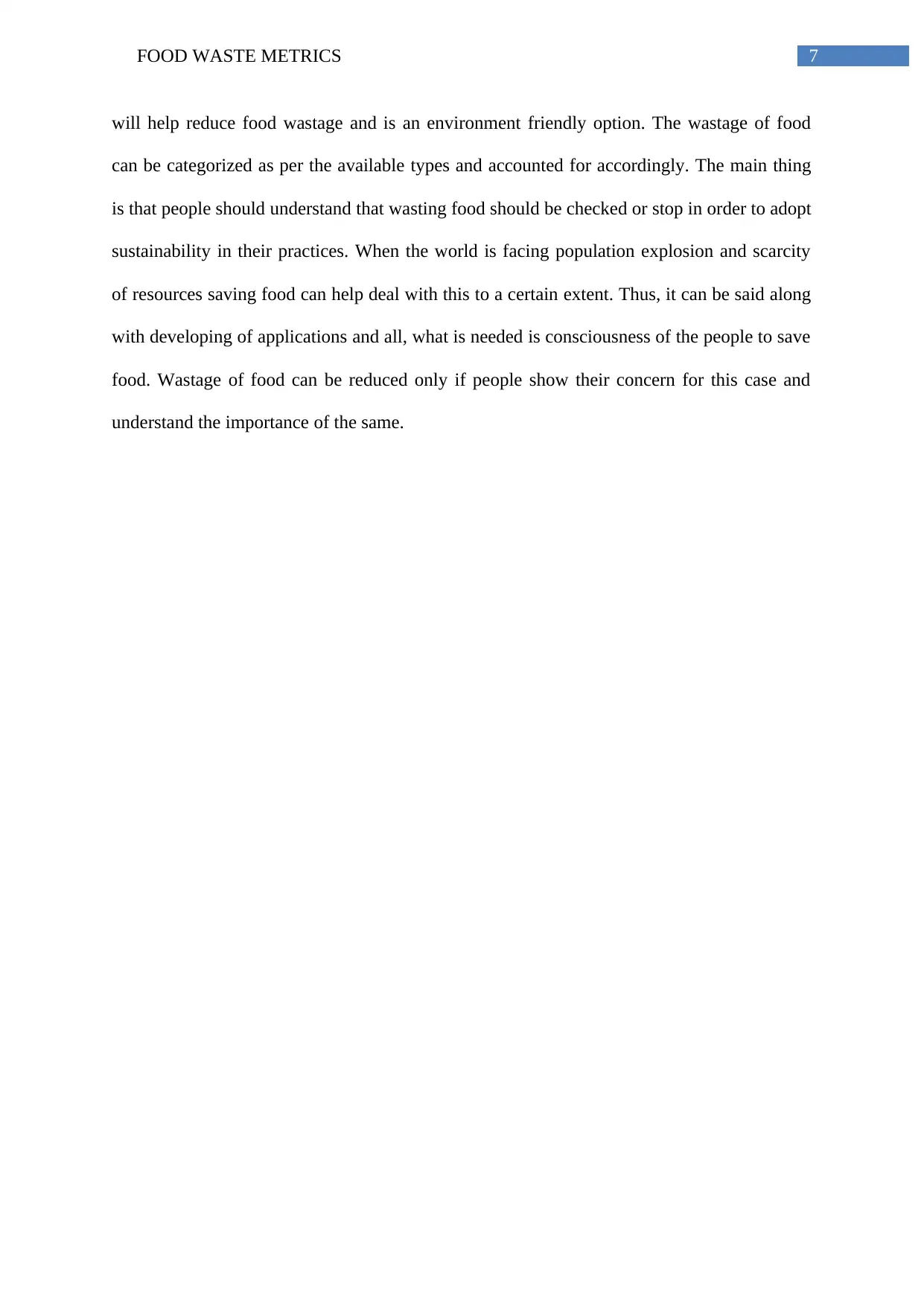
7FOOD WASTE METRICS
will help reduce food wastage and is an environment friendly option. The wastage of food
can be categorized as per the available types and accounted for accordingly. The main thing
is that people should understand that wasting food should be checked or stop in order to adopt
sustainability in their practices. When the world is facing population explosion and scarcity
of resources saving food can help deal with this to a certain extent. Thus, it can be said along
with developing of applications and all, what is needed is consciousness of the people to save
food. Wastage of food can be reduced only if people show their concern for this case and
understand the importance of the same.
will help reduce food wastage and is an environment friendly option. The wastage of food
can be categorized as per the available types and accounted for accordingly. The main thing
is that people should understand that wasting food should be checked or stop in order to adopt
sustainability in their practices. When the world is facing population explosion and scarcity
of resources saving food can help deal with this to a certain extent. Thus, it can be said along
with developing of applications and all, what is needed is consciousness of the people to save
food. Wastage of food can be reduced only if people show their concern for this case and
understand the importance of the same.
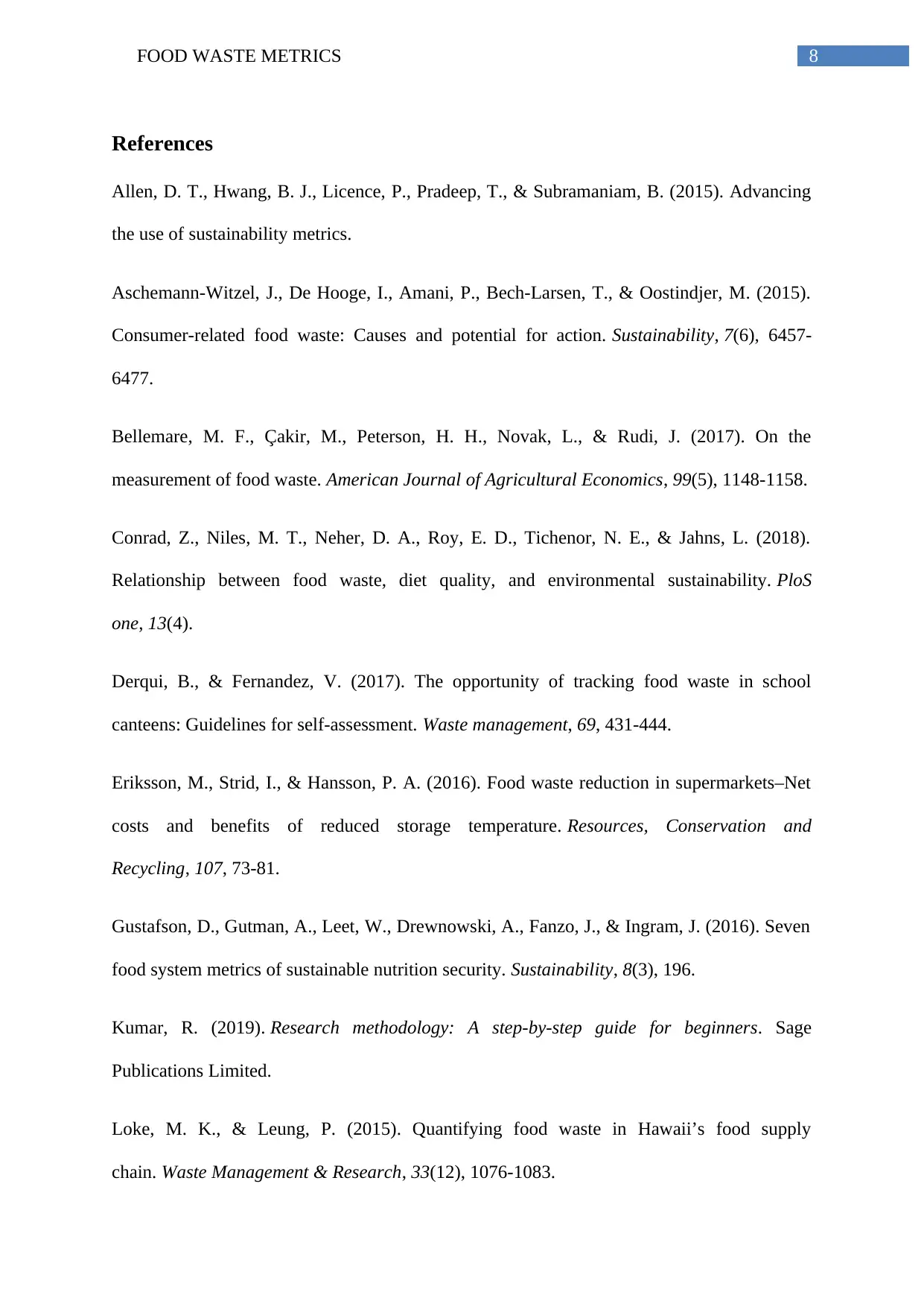
8FOOD WASTE METRICS
References
Allen, D. T., Hwang, B. J., Licence, P., Pradeep, T., & Subramaniam, B. (2015). Advancing
the use of sustainability metrics.
Aschemann-Witzel, J., De Hooge, I., Amani, P., Bech-Larsen, T., & Oostindjer, M. (2015).
Consumer-related food waste: Causes and potential for action. Sustainability, 7(6), 6457-
6477.
Bellemare, M. F., Çakir, M., Peterson, H. H., Novak, L., & Rudi, J. (2017). On the
measurement of food waste. American Journal of Agricultural Economics, 99(5), 1148-1158.
Conrad, Z., Niles, M. T., Neher, D. A., Roy, E. D., Tichenor, N. E., & Jahns, L. (2018).
Relationship between food waste, diet quality, and environmental sustainability. PloS
one, 13(4).
Derqui, B., & Fernandez, V. (2017). The opportunity of tracking food waste in school
canteens: Guidelines for self-assessment. Waste management, 69, 431-444.
Eriksson, M., Strid, I., & Hansson, P. A. (2016). Food waste reduction in supermarkets–Net
costs and benefits of reduced storage temperature. Resources, Conservation and
Recycling, 107, 73-81.
Gustafson, D., Gutman, A., Leet, W., Drewnowski, A., Fanzo, J., & Ingram, J. (2016). Seven
food system metrics of sustainable nutrition security. Sustainability, 8(3), 196.
Kumar, R. (2019). Research methodology: A step-by-step guide for beginners. Sage
Publications Limited.
Loke, M. K., & Leung, P. (2015). Quantifying food waste in Hawaii’s food supply
chain. Waste Management & Research, 33(12), 1076-1083.
References
Allen, D. T., Hwang, B. J., Licence, P., Pradeep, T., & Subramaniam, B. (2015). Advancing
the use of sustainability metrics.
Aschemann-Witzel, J., De Hooge, I., Amani, P., Bech-Larsen, T., & Oostindjer, M. (2015).
Consumer-related food waste: Causes and potential for action. Sustainability, 7(6), 6457-
6477.
Bellemare, M. F., Çakir, M., Peterson, H. H., Novak, L., & Rudi, J. (2017). On the
measurement of food waste. American Journal of Agricultural Economics, 99(5), 1148-1158.
Conrad, Z., Niles, M. T., Neher, D. A., Roy, E. D., Tichenor, N. E., & Jahns, L. (2018).
Relationship between food waste, diet quality, and environmental sustainability. PloS
one, 13(4).
Derqui, B., & Fernandez, V. (2017). The opportunity of tracking food waste in school
canteens: Guidelines for self-assessment. Waste management, 69, 431-444.
Eriksson, M., Strid, I., & Hansson, P. A. (2016). Food waste reduction in supermarkets–Net
costs and benefits of reduced storage temperature. Resources, Conservation and
Recycling, 107, 73-81.
Gustafson, D., Gutman, A., Leet, W., Drewnowski, A., Fanzo, J., & Ingram, J. (2016). Seven
food system metrics of sustainable nutrition security. Sustainability, 8(3), 196.
Kumar, R. (2019). Research methodology: A step-by-step guide for beginners. Sage
Publications Limited.
Loke, M. K., & Leung, P. (2015). Quantifying food waste in Hawaii’s food supply
chain. Waste Management & Research, 33(12), 1076-1083.
⊘ This is a preview!⊘
Do you want full access?
Subscribe today to unlock all pages.

Trusted by 1+ million students worldwide
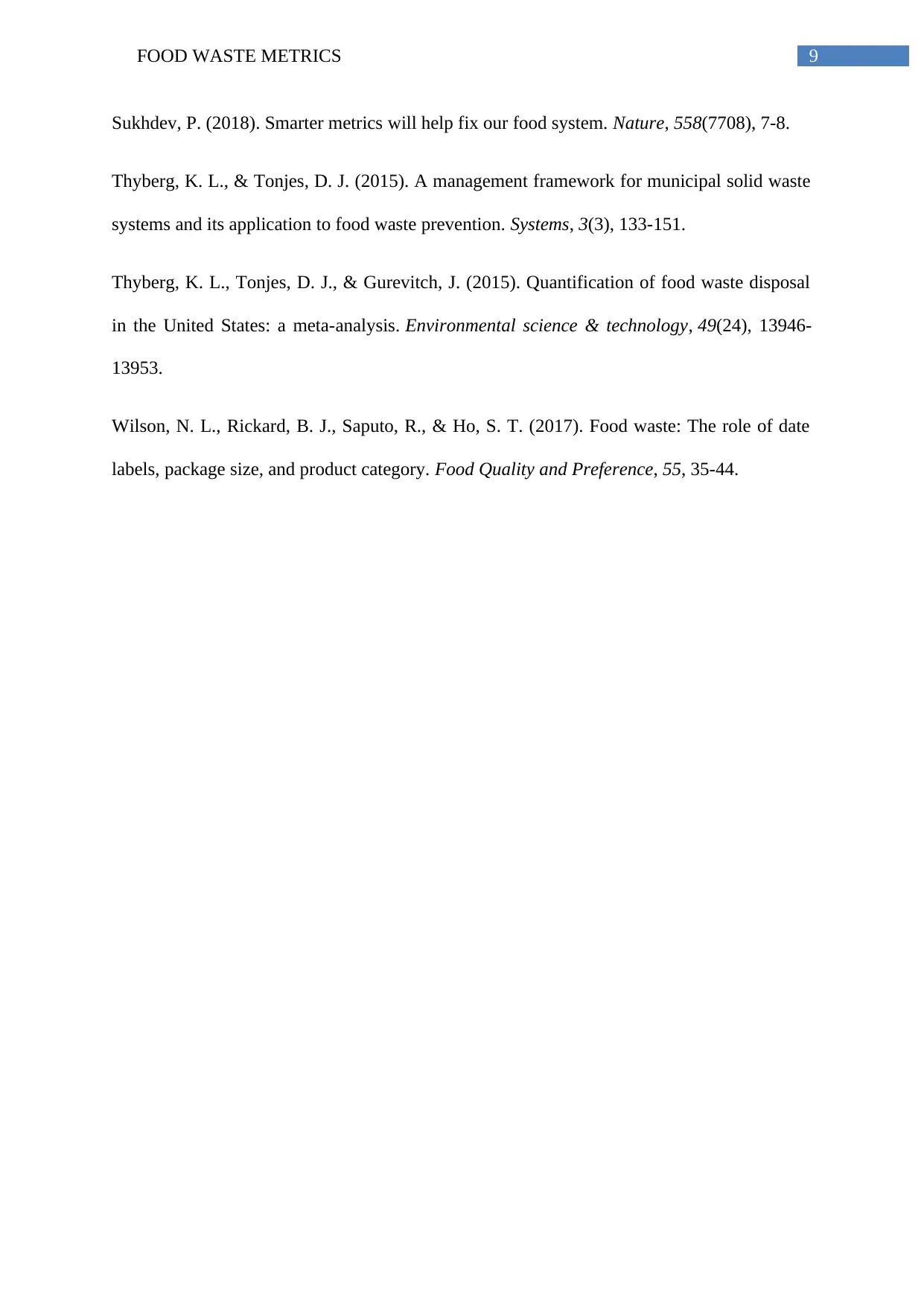
9FOOD WASTE METRICS
Sukhdev, P. (2018). Smarter metrics will help fix our food system. Nature, 558(7708), 7-8.
Thyberg, K. L., & Tonjes, D. J. (2015). A management framework for municipal solid waste
systems and its application to food waste prevention. Systems, 3(3), 133-151.
Thyberg, K. L., Tonjes, D. J., & Gurevitch, J. (2015). Quantification of food waste disposal
in the United States: a meta-analysis. Environmental science & technology, 49(24), 13946-
13953.
Wilson, N. L., Rickard, B. J., Saputo, R., & Ho, S. T. (2017). Food waste: The role of date
labels, package size, and product category. Food Quality and Preference, 55, 35-44.
Sukhdev, P. (2018). Smarter metrics will help fix our food system. Nature, 558(7708), 7-8.
Thyberg, K. L., & Tonjes, D. J. (2015). A management framework for municipal solid waste
systems and its application to food waste prevention. Systems, 3(3), 133-151.
Thyberg, K. L., Tonjes, D. J., & Gurevitch, J. (2015). Quantification of food waste disposal
in the United States: a meta-analysis. Environmental science & technology, 49(24), 13946-
13953.
Wilson, N. L., Rickard, B. J., Saputo, R., & Ho, S. T. (2017). Food waste: The role of date
labels, package size, and product category. Food Quality and Preference, 55, 35-44.
1 out of 10
Related Documents
Your All-in-One AI-Powered Toolkit for Academic Success.
+13062052269
info@desklib.com
Available 24*7 on WhatsApp / Email
![[object Object]](/_next/static/media/star-bottom.7253800d.svg)
Unlock your academic potential
Copyright © 2020–2025 A2Z Services. All Rights Reserved. Developed and managed by ZUCOL.





